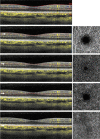Pearls and Pitfalls of Optical Coherence Tomography Angiography Imaging: A Review
- PMID: 30868418
- PMCID: PMC6513942
- DOI: 10.1007/s40123-019-0178-6
Pearls and Pitfalls of Optical Coherence Tomography Angiography Imaging: A Review
Abstract
Optical coherence tomography angiography (OCTA) has significantly expanded our knowledge of the ocular vasculature. Furthermore, this imaging modality has been widely adopted to investigate different ocular and systemic diseases. In this review, a discussion of the fundamental principles of OCTA is followed by the application of this imaging modality to study the retinal and choroidal vessels. A proper comprehension of this imaging modality is essential for the interpretation of OCTA imaging applications in retinal and choroidal disorders.
Keywords: Choriocapillaris; Choroid; Image analysis; Optical coherence tomography angiography; Retinal vessels.
Figures



References
-
- Borrelli E, Sarraf D, Freund KB, Sadda SR. OCT angiography and evaluation of the choroid and choroidal vascular disorders. Prog Retin Eye Res. 2018;67:30–55. - PubMed
-
- Tan PEZ, Yu PK, Balaratnasingam C, Cringle SJ, Morgan WH, McAllister IL, et al. Quantitative confocal imaging of the retinal microvasculature in the human retina. Investig Ophthalmol Vis Sci. 2012;53:5728–5736. - PubMed
-
- Chan G, Balaratnasingam C, Yu PK, Morgan WH, McAllister IL, Cringle SJ, et al. Quantitative morphometry of perifoveal capillary networks in the human retina. Investig Ophthalmol Vis Sci. 2012;53:5502–5514. - PubMed
-
- Ghasemi Falavarjani K, Al-Sheikh M, Akil H, Sadda SR. Image artefacts in swept-source optical coherence tomography angiography. Br J Ophthalmol [Internet]. 2016. http://bjo.bmj.com/lookup/doi/10.1136/bjophthalmol-2016-309104. Cited 19 Jan 2017. - DOI - PubMed
Publication types
LinkOut - more resources
Full Text Sources

